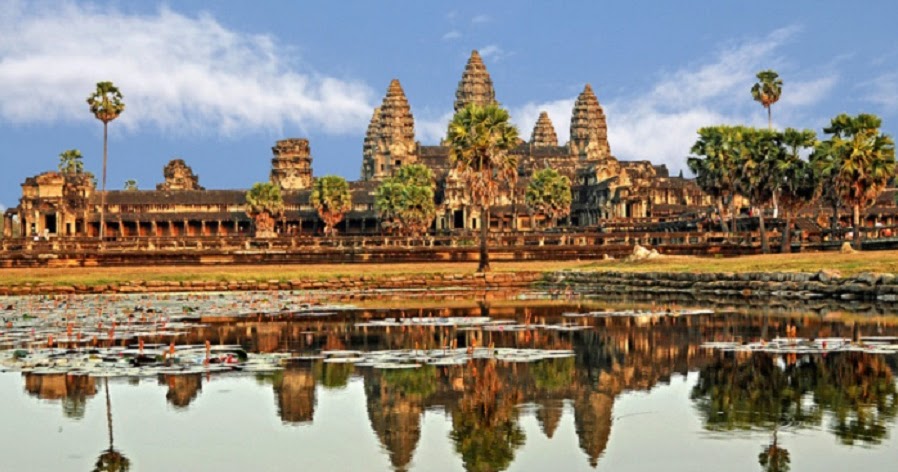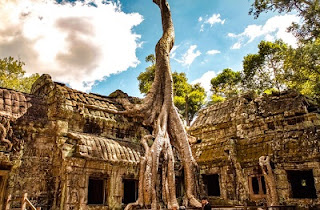|
Important Note:
|
| [Angkor Wat at Sunrise] [Picture Credits: “Cambodia-2638B – Angkor Wat” by Dennis Jarvis, Flickr is licensed under CC BY-SA 2.0] |
Angkor Wat was
originally constructed as a Hindu temple and a capital city dedicated to the
God Vishnu by Khymer King Suryavarman in the first half of 12th century.
But
by the end of the 12th century, it was considered a Buddhist site. Theravada Buddhism gained popularity by that time,
and maybe the reason for the change. Angkor Wat is the most popular tourist and
heritage spot in Cambodia located in the Siem Reap region in Northern Cambodia,
around 5-6 km away from the temple complex.
There are other temples in the
vicinity which I will cover later, one of them being the location for the
iconic film ‘Tomb Raider‘ shoot. This sprawling temple complex is
considered a 7th wonder in the world due to the remote location and massive
area, which is around 400 acres. In ancient times, it was a prosperous and
fertile city having a population of around 1 million people. It also achieved
the sobriquet as the ‘City of temples‘ due to numerous temples
in and around the vicinity of Angkor Wat. It was also called ‘Praha Vishnuloka‘ in
ancient times and regarded as a sacred dwelling of Lord Vishnu. At times it was
thought to be a ‘Jetavana‘ garden of Buddha, similar to the one in
Magadha, Bihar, India.
There was a deep cultural connection between India & Cambodia right from 1 Century BCE.
This is reflected in Sanskrit inscriptions found on the temple walls, resident brahmin priests,
pottery findings, the discovery of Brahmi script, similar astronomical
calculations, Gupta style architecture, and worshipping of deities Hanuman and
Shiva.
In
fact, this temple was called India’s twin and was inspired by the Mahabalipuram
temple in TN. Legend states that Suryavarman was a descendent of Cholas, the
rulers of Tamil Nadu. Much of the temple was constructed in sandstone with 15
feet high walls surrounded by a moat, which protected the city from foreign
invasion. A straight causeway joins right to the temple complex.
Angkor
was also renowned for its excellent rainwater harvesting canals, reservoirs,
and dikes, the largest of which spanned 8kms. This is nothing but an
engineering feat. Even the moats depicted the design of the Hindu cosmic
mountain of Mount Meru.
The
temple complex soars majestically in the forested area and was first discovered
by a French Naturalist Henri Mahout in 1860, and termed it as next only to
Temple of Solomon in majesty. But the first western visitor was Antonio
Madalena, a Portuguese Capuchin friar who was awestruck by the monumental
architecture with sky-high towers, and aesthetic designs. He further went on to
say that “There is no building in the world which can rival in grace
and refinements as this, which only a genius could conceive in his mind. This
is even grander than anything left by the Romans & Greeks“.
It has 5 huge lotus-shaped towers that raise 65 meters into the sky which is mind-blowing. The empire spanned much of South East Asia, spreading from Cambodia, Burma, Vietnam, Laos, Thailand, etc..
The first level exterior walls have Bass reliefs depictions and carvings of deities, animal figures, celestial dancers (apsaras/nymphs), and is a sight to behold. Even the mythological churning of the ocean ‘Samudra Manthana‘ is depicted on the exterior walls. Photography is allowed at the temple site, but its best to take a shot during sunset and sunrise periods, which is truly magical.
The temple complex has achieved cult status and is depicted on Cambodia’s National
Flag, coins, stamps & currency notes. This is one of the hidden and lost
civilizations of the yesteryears, whose beauty and construction is
unparalleled. Further 25miles north of Angkor, you can unravel the ruins of the
lost, hidden, and first capital city of the Khmer Empire, Mahendraparvata,
which was the building template for the construction of Angkor Wat
If
you want to understand the architectural and engineering marvels of olden
times, then a visit to Phnom Pehn and Siem Reap is a must. Angkor Wat was the
largest religious complex in the whole world during its heydays, and even now.
But with the passage of times and vagaries of nature, the sprawling complex is
in the grip of the huge Banyan tree and Silk cotton tree roots, which has
choked it on all sides. It was declared a UNESCO World Heritage site and was considered the largest city
before the industrial era.
Tourists specially visit this temple for its sunrise and sunset which is a visual spectacle.
Some other famous temples in the vicinity are Bayon and Ta Prohm. Phnom
Bakheng is a 70 feet high hill from where you can catch a glimpse of the
temple.
Ta Prohm was made famous by the shoot of the iconic film of Lara Croft ‘Tomb Raider’ and it catapulted this temple to international acclaim.
Bayon is another spectacular temple, that has many mysterious smiling stone faces chiseled with utmost precision. It is richly decorated with bass reliefs of mythological figures. It is the only Angkorian temple built as per the Mahayana style of Buddhism. It is so-called due to the many representations of Buddha’s faces depicting him as Avalokiteshwara or Lokeshwara.
The original name of Bayon was ‘Jayagiri‘ or Victory mountain.
King Jayavarman considered himself the Bodhisattva or Devraja (King God).
Open Timings for visiting Angkor Wat: 5am to 7pm.
Arrival Formalities:
There is a facility for Visa on Arrival (VOA) for a tourist visa which costs around $30 and can be obtained at Phnom Pehn and Siem Reap airports.
The Cambodian Riel and US dollars are the officially accepted currencies here. The dollar is traded at almost all places, except for street-side stores. You can trade here in a mix of Riel & Dollars.
For your information, 1 Dollar = 4 Cambodian Riels. Purchasing SIM cards is very easy and you can find them at airports for $5(25G). At retailers, you can source Smart SIM Cards for $3 with 1-month validity.
How to get to Angkor:
The religious town of Siem Reap can be reached by bus(IBIS Bus=Almost $17) or taxi from Phnom Penh which takes about 6 hrs. You can also travel by waterways, at around the same time as road travel from the capital city. Siem Reap has its own airport and you can reach Phnom Penh, Vietnam, Thailand, Laos, Singapore from here.
Booking.com &12GoAsia.com have very good options for getting ideas on the travel itinerary, schedules, and prices beforehand to save a great deal of your time and energy.
Navigating through Khmer is only by Tuk Tuk and you can avail them for $1-$2. You can also download Grab App for getting an even cheaper deal.
Entrance Pass:
You need a valid Angkor complex pass to pass in the Angkor Archeological Park without which you can be fined. Passes are available for 1 day, 3 days, 7 days, etc.. If you purchase a multi-day pass, then you can enter in any day to visit the complex. There is a validity period for a 3 & 7-day pass which is printed on the ticket.
When to visit:
The peak season starts from December till May. Rains are unforgiving, so better plan your trip during winters and summers.
How to plan the visit:
Balloon rides give an aerial glimpse of the temple. If you want to visit some other complexes and off the beaten structures, then you can hire a cab or motorbike with registered guides. Siem Reap town is urbanized, and you will find plenty of lodging, dining, and tour package options.
Cultural
aspects & Seasonal necessities:
Angkor Wat
has a hot, tropical climate and its best acclimatized by wearing sunscreen, cap
& UV Sunglasses. It’s best to enjoy this place in light clothing. The rainy
season demands a sturdy umbrella and boots. The hard terrain can take a toll on
your shoes, so try to wear rugged shoes with hard soles.
You can tip
the tour guides and waiters as a token of good service in Siem Reap.
There
are numerous vendors, stalls, and restaurants selling their wares around the
temple complex. You can bargain for Souvenirs, guide books, snacks, etc..
Beverages are pricey, so it’s better to carry your own bottle.
You
can hire an authorized guide and Tuk Tuk for navigating the temple complex. But
since its a world heritage site, there are unregistered guides too, trying to
make a quick buck.
Navigating
the temple complex in a Tuk-Tuk costs $13 for 7hrs, but there’s also a $5 extra
charge for pickup at sunrise.
If you plan
to hire a vehicle, then it is the norm here to drive on the right-hand side of
the road.
Some cultural Lingo to learn:
- Susadei – ‘Hello‘
- Ot Thei – ‘No‘
- Arkun – ‘Thank You’
Popular local beverages:
- Tomb Raider cocktail made famous by Lara Croft film ‘Tomb Raider’
- Anchor beer
If you prefer outdoor settings then
visit Temple Bare, which is the best rooftop bar in Siem Reap.
Drinking Spots:
- Miss Wong – Old
world charm bar with lanterns, and vintage items all over. - Angkor Wat – Chic
pub which serves drinks by a bucket.
Gastronomy spots:
- Mie Cafe – Offers
succulent meat dishes and fish menu. - Cuisine Wat Damnak: This is
a restaurant with traditional Cambodian style cooking.
Hotels in Siem Reap:
- Budget hostel – Chilled
Backpacker(quiet and decent) - Mid-tier hotel – Baby
Elephant Boutique Hotel - Boutique Hotel – Everland
- Luxury Hotel – Belmond
Angkor has private balconies constructed using locally crafted materials.
Walls are adorned with bespoke artwork created by contemporary Cambodian
artists.
The first two hotels are located in the
Wat Bo area, around 10-15 min walk from the riverside to the city center.
Luxury hotels such as Park Hyatt & Angkor Note residence are also favored
by high-end tourists. Bopha Angkor is a chic hotel with spacious rooms, very
near to Siem Reap. Do visit Blue Pumpkin Cafe for light snacks and icecreams.
This is a famous hanging spot for expatriates and tourists.
Iconic Shopping Areas:
- Made in Cambodia Market – Locals only artisan market where you can scout for local woven scarves, woven straw bags, wooden sculptures, and other souvenirs items to take as a
memory. - Artisans Angkor – Local enterprise which promotes the rural Khmer craft, wood carvings, stone
arts, and handmade products.
Bets Travel Deal websites: (Assuming you have taken your travel insurance)
- Airbnb: Local
homestays and apartments in cities, rented by homeowners. You even get a
discount on your first stay. - Momondo: A
classic flight search engine. - Hostelword: Hostel
search engine. - Agoda: Best hotel booking search engine.
Nearby attractions in Siem Reap:
- Angkor Palace – Palace
of King Jayavarman. - Angkor Elephant terrace – 1000ft
elephant terrace. It was a viewing gallery during public & royal ceremonies. - Srah Srang: Known as the ‘Royal Baths’, since it was a popular bathing area.
- Tonle Sap Lake – The tourism department conducts sailing adventures here. It is considered the largest lake in Asia, where people reside in floating villages.




